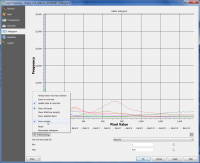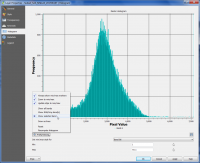Raster histogram
From AWF-Wiki
(Difference between revisions)
(→Using Layer Properties) |
|||
| (10 intermediate revisions by one user not shown) | |||
| Line 1: | Line 1: | ||
== Using Layer Properties == | == Using Layer Properties == | ||
| − | # Click the {{button|text=Add raster layer}} [[Image:QGIS_2.0_addrast.png|20px]] and select | + | # Click the {{button|text=Open Data Source Manager}} [[Image:QGIS_3.0_datasource.png|30px]] and then {{button|text=Add raster layer}} [[Image:QGIS_2.0_addrast.png|20px]] and select a single or a multiband band raster file. |
# After clicking {{button|text=Open}} , the raster layer appears on the QGIS canvas. | # After clicking {{button|text=Open}} , the raster layer appears on the QGIS canvas. | ||
# Right click the layer name in the Layers panel and select {{mitem|text=Properties --> Histogram}} | # Right click the layer name in the Layers panel and select {{mitem|text=Properties --> Histogram}} | ||
| − | + | # Click {{button|text=Compute Histogram}}. A histogram for all bands is displayed (Figure '''A'''). Left click and drag a box on the diagram to zoom in. [[File: Qgis_histogram_multiband.png|thumb|left|200px|'''Figure A:''' Line histograms of all bands]] | |
| − | Click | + | |
| − | [[File: Qgis_histogram_multiband.png|thumb|left|200px|'''Figure A:''' Line histograms of all bands]] | + | |
Click on {{button|text=Pref/Actions}} and deactivate ''Draw as lines''. Activate ''Show selected band'' and ''Always show min/max markers''. | Click on {{button|text=Pref/Actions}} and deactivate ''Draw as lines''. Activate ''Show selected band'' and ''Always show min/max markers''. | ||
The value range of the selected band data is evenly divided into bins. The histogram shows how many pixels of the image fall into each of the bins (Figure '''B''')[[File: Qgis_histogram_singleband.png|thumb|right|200px|'''Figure B:''' Histogram of a single selected band]]. Click on [[File: Qgis_save_icon.png|20px]]. The graphics may be saved as png file. | The value range of the selected band data is evenly divided into bins. The histogram shows how many pixels of the image fall into each of the bins (Figure '''B''')[[File: Qgis_histogram_singleband.png|thumb|right|200px|'''Figure B:''' Histogram of a single selected band]]. Click on [[File: Qgis_save_icon.png|20px]]. The graphics may be saved as png file. | ||
| − | |||
| − | |||
| − | |||
| − | |||
| − | |||
| − | |||
| − | |||
| − | |||
| − | |||
[[Category: Working with Raster Data]] | [[Category: Working with Raster Data]] | ||
Latest revision as of 12:44, 2 November 2020
[edit] Using Layer Properties
- Click the Open Data Source Manager
 and then Add raster layer
and then Add raster layer  and select a single or a multiband band raster file.
and select a single or a multiband band raster file.
- After clicking Open , the raster layer appears on the QGIS canvas.
- Right click the layer name in the Layers panel and select Properties --> Histogram
- Click Compute Histogram. A histogram for all bands is displayed (Figure A). Left click and drag a box on the diagram to zoom in.
Click on Pref/Actions and deactivate Draw as lines. Activate Show selected band and Always show min/max markers.
The value range of the selected band data is evenly divided into bins. The histogram shows how many pixels of the image fall into each of the bins (Figure B). Click on
